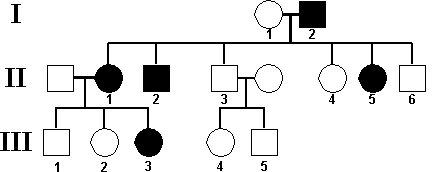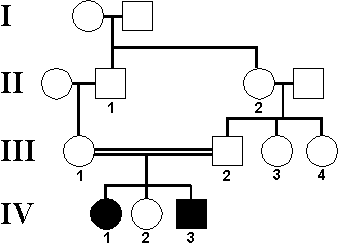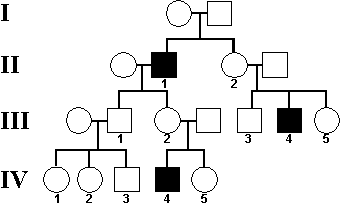

 |
Topics covered on this page are:
|
Some traits have genes with more than two alleles. These are called multiple alleles, but any one individual can still have only two alleles (one on each of the homologous chromosomes).
The human blood group gene provides an example of this, as well as an interesting dominance relationship. There are three A,B O blood group alleles, usually given the symbols IA, IB and Ii . IA and IB are codominant to each other, but are both dominant to Ii . Since any individual only has two alleles, there are four possible blood group phenotypes but nine possible genotypes.
Copy the Punnett square which follows onto a sheet of paper (don't print it - save a tree and use some scrap paper!). Use it to work out the genotypes and phenotypes of human blood groups, assuming that all three alleles are equally possible in all parents.| IA | IB | Ii | |
|---|---|---|---|
| IA | |||
| IB | |||
| Ii |
When several genes influence a trait, such as the genes for height or weight, it is difficult to determine the effect of any one of these genes.
Such traits, with many genes influencing them are examples of polygenic inheritance. Assuming that the genes are on different chromosomes, we know that they will segregate independently during meiosis. Polygenic inheritance then becomes a genetic problem of at least the complexity of a dihybrid cross (for two genes) and possibly much more complex (if more than two genes are involved).
The resulting variety of possible genotypes can give a large number of phenotypes, and when the influence of the environment is also considered, it is hardly surprising that almost every possible variety of phenotype can be observed in a large population. This is termed continuous variation.
If the chromosomes in a gamete producing cell are not broken up or rearranged during meiosis, it would be expected that all the genes on a particular chromosome would be transferred together into whichever gamete gets that particular chromosome. That is the genes are linked together on their chromosome.
Linked genes (ie genes on the same chromosome) would be expected to be inherited together unless something happens during meiosis to separate them.
In a classic experiment using Drosophila (fruit flies) the geneticist T.H.Morgan demonstrated this linkage. The results of this experiment follow:
G = grey wings, g = black wings AND W =normal wings, w= small wings| GW | Gw | gW | gw | |
|---|---|---|---|---|
| gw | |
|||
| gw | |
|||
| gw | |
|||
| gw | |
| Genotype, Phenotype |
Theoretical % | Actual % |
|---|---|---|
| GgWw grey, normal wings |
||
| Ggww grey, small wings |
||
| ggWw black, normal wings |
||
| ggww black, small wings |
This seemingly odd result can be understood if it is assumed (correctly) that the genes for wing colour and size are actually on the same chromosome, but fairly widely separated. In this case the genes are usually inherited together - for example gametes of the first parent would mostly have GW or gw genotype unless crossing over swapped the ends of the chromosomes to (rarely) give the recombinants gW and Gw. So instead of all four gamete types being equally likely, and the 1:1:1:1 ratio of phenotypes being observed in the offspring, the apparently odd results are explained.
The percentage of the recombinant offspring in a test cross such as this (a cross of the heterozygote with a homozygous recessive individual) gives an estimate of the distance between the linked genes. It is more likely that crossing over, and separation of the linked genes, will occur if the genes are widely separated on the chromosome.
These types of linkage experiments are widely used by geneticists to build up chromosome maps. Chromosome maps, sometimes called linkage maps, are maps or diagrams of individual chromosomes on which lines are drawn to represent the genes known to be on that particular chromosome. The positions of the lines, and the distances between them, are determined by analysis of linkage data such as that described above.
Two more techniques used in genetics experiments are testcrosses and backcrosses.
In a testcross, an individual who is homozygous recessive (say tt) is crossed (mated) with an individual with the dominant phenotype to determine that individual's genotype. (The dominant phenotype means that the genotype could be Tt or TT.) The phenotypes and ratios of the offspring of such a testcross reveals the unknown genotype. (Do the possible Punnett squares to satisfy yourself of the outcomes.)
In a backcross, an F1 generation organism is mated back to one of its parents. If the F1 has the dominant phenotype and it is mated back to a parent with the recessive phenotype, then this is the same as a testcross. In this case the backcross may be used to gain genetic information about the other parent if this is not known. This type of mating can also be carried out to deliberately increase the inbreeding in the population. This can be useful in breeding plants or animals with desirable characteristics for farming.
In humans, the gender of an individual is determined by the particular combination of one of the pairs of chromosomes that individual possesses, Because these chromosomes are so important, they are often called the sex chromosomes. They are given names, X and Y, in humans but other letters in some other species.
Like the autosomes, the sex chromosomes are randomly assorted during gamete formation.
Possession of two X chromosomes in humans gives the genotype XX and the phenotype female. The genotype XY gives the phenotype male.
The Punnett square which follows shows why there are approximately equal numbers of male and female individuals born. However, due to environmental factors, that ratio is not usually maintained as people get older.
| X | Y | |
|---|---|---|
| X | ||
| X |
It is clear that in mammals it is the sex chromosome of the sperm which determines the gender of the offspring. Sperm can carry either an X or a Y sex chromosome. But all ova carry X chromosomes. So the sperm, either X or Y carrying, which is used to fertilise the ovum determines the gender of the offspring - female XX or male XY respectively.
In the interest of your complete biological education, you should know that the gender determination in birds is significantly different to that of humans and other mammals. Birds' sex chromosomes are named W and Z. The female has the genotype ZW and the male has the genotype ZZ. So in birds, it is the particular ovum which determines offspring gender, as ova can contain either Z or W sex chromosomes. Bird sperm all contain the Z sex chromosome. (You'll notice that even in birds, I have called the female gametes ova. This is the correct biological term. However, in common language the term egg is used for a bird ovum - try to be biological and use the correct term in answering exam questions.)
Many insects, including the honey bee, have an even more complex system of gender determination. There is only one sex chromosome, called X, but how many an individual has and the environment are the factors that determine not only gender but the role in the bee society that the individual plays:
compliment |
||
|---|---|---|
| DRONE (male) |
Haploid sex chromosomes XO (O = absent) |
Drones develop from unfertilised ova of the Queen bee. Drones can produce haploid sperm by mitosis. |
| WORKER (female) |
Diploid sex chromosomes XX |
Sterile workers develop from fertilised Queen bee ova. The larvae are raised in the absence of royal jelly. The workers do not produce gametes. |
| QUEEN (female) |
Diploid sex chromosomes XX |
Queen bees develop from fertilised ova. Larva is fed royal jelly which is rich in protein. Queen bees produce gametes by meiosis. The haploid gametes (ova) may be fertilised to create females, or unfertilised to create drones. |
Well now that the truth about the birds and the bees has been revealed to you, perhaps it's time you had a chat to your parents and told them that they got it all wrong!
![]() Back to the top of this page
Back to the top of this page
Whilst it is true that the sex chromosomes have important information for the determination of gender, that is not all the genetic information that they carry.
However, the X and Y chromosomes, unlike all of the autosomes, are not a completely "matched pair". In fact the Y chromosome is less than half the length of the X chromosome. Apart from the alleles determining "maleness", which are dominant to the corresponding alleles on the X chromosome, there does not appear to be much genetic information at all on the Y chromosome.
The X chromosome, however, does carry some important genetic information and without at least one X chromosome life is impossible. In fact, there are over 150 traits mapped on the X chromosome.
In a female, with XX genotype, normal dominant/recessive rules apply to the phenotype for these X-linked traits. But in the male, with only one X chromosome, the allele on that X chromosome will always be expressed in the phenotype as there is no corresponding allele on the Y chromosome to affect it.
In working through problems concerning sex-linked, or more properly X-linked, genes, you need to keep track of both the X and Y chromosomes as well as the different alleles which an X chromosome may carry.
An example will illustrate this.
Red-green colour blindness, in which the green-sensitive cones in the retina are defective, is due to an X-linked recessive allele. The symbols needed to follow this allele through a Punnett square are
XC = X chromosome carrying the normal (dominant) alleleSuppose a woman with a colour-blind father, and a mother with no history of colour blindness in her family, marries a man with normal colour vision. What are the likely genotypes and phenotypes of any children they have?
Woman's genotype must be XCXc (Since she has inherited XC from her normal mother and Xc from her colour blind father.)Punnett squares of possible gametes and resulting offspring gives us:
| XC | Y | |
|---|---|---|
| XC | ||
| Xc |
This is another area of the VCE biology syllabus where you would benefit from doing LOTS of practice problems.
These are a convenient graphical way to follow the passage of a trait (just one trait per diagram) through many generations. They are used by animal and plant breeders, as well as people interested in human traits, to keep track of, and sometimes predict, the occurrence of the phenotype of interest.
From the relationships within the pedigree, the genotypes of certain individuals may be (but cannot always be) deduced.
Some textbooks try to offer "rules" for interpretation of pedigree diagrams. Beware of these! They are complex to learn and they often don't work!
There are, however, a few conventions which you do need to remember before you can work out the genetics of a family's pedigree:
| SYMBOL | Meaning |
|---|---|
| determined by the trait. |
|

|
|

|
|

|
There are some more symbols which you may discover if you do plenty of practice questions, but they should be easy to work out.
Generations in a pedigree diagram are numbered, by convention, using Roman numerals, starting with the parental generation, at the top of the diagram as generation I. The first filial generation, which we have called F1 earlier, would be generation II in a pedigree diagram.
For convenience, the members of each generation are numbered across the line, from left to right, using normal numerals.
Below are three pedigree diagrams. They represent the three most common forms of inheritance seen in genetics, autosomal dominant, autosomal recessive and X-linked recessive respectively.


Humans have been manipulating the phenotypes of useful species for thousands of years. Recently, understanding of the molecular biology of genes and their action has opened up new areas for humans to exploit.
Whilst it is not appropriate to give lengthy descriptions here of all the ways DNA and genes are manipulated, students should read widely on this topic. It is not until you understand the many applications of our knowledge of the molecular biology of the gene that you will appreciate the potential that this area of biology has for the future.
By selecting plants (such as food crops) and animals for their desirable phenotypes and using them to produce the next generation, humans have been manipulating many species for hundreds of generations. The results are usually seen as desirable to the breeders and farmers who become more productive using the species produced by these selective breeding techniques.
Occasionally, unwelcome outcomes develop from these breeding processes - susceptibility to disease in crops such as wheat, skeletal problems in some 'breeds' of the domestic dog.
It has recently (in the last 30 years) become possible for geneticists to use restriction enzymes to cut pieces of DNA from chromosomes. Once this is done, selected pieces of DNA may be inserted in to the DNA from a different species, often a bacterium because these are so easy to grow quickly in large numbers. The altered transgenic organism will then express the information on the added DNA, producing the gene product, a polypeptide, often in large amounts.
It is a simple matter, then, to "harvest" the desired protein, purify it, and use it for whatever purpose it is needed. This is the method now used to produce the hormone insulin for use by diabetics.
In other cases, the transgenic organism, perhaps a plant such as a strawberry, will have acquired a gene which confers a specially desirable property on it. Strawberries have been altered to be resistant to frost and are therefore able to be grown in previously impossible locations.
The possibilities for transgenic organisms are just unfolding. Used with care, these techniques may improve the quality of life for all humans.
Once an organism with desirable characteristics has been developed, either by selective breeding or by genetic engineering techniques, the special set of genes it possesses may be maintained if all future reproduction is by mitosis.
Remember that mitosis accurately transfers genetic information from generation to generation of cells with little opportunity for alteration of that information. On the other hand, meiosis, and sexual reproduction, mixes up the genes both within the gametes and during the process of fertilization.
By carefully controlling the conditions in which a sample of tissue is suspended, molecular biologists can establish many generations if identical cells. This is known as cloning. A clone is a large population of genetically identical cells, derived from one original cell.
At the level of the whole organism, a clone is a number of genetically identical organisms, produced from one original parent organism. This is relatively easy to achieve in plants, where cuttings, tissue culture and grafting are all methods of reproduction my mitosis to give new plants or parts of plants.In bacteria, this is the normal mode of reproduction, although some strains of bacteria do, under some circumstances, exchange genetic material in a form of sexual reproduction.
In mammals cloning is much more difficult to do. Earlier this year, Scottish geneticists reported cloning a sheep, Dolly, using the nucleus of a somatic cell and implanting that into an enucleated ovum from a different sheep. The ovum was then implanted in a receptive ewe's uterus and developed into a lamb which was named Dolly. No-one knows yet exactly how Dolly will develop, and whether or not it will be normal in all respects. Very recently, American scientists have reported the cloning of a cow. Not surprisingly, they named their clone Gene! This interesting new technology will provide more news in the future - keep listening for the latest!
The increased understanding of chromosomes, genes and genetic engineering has led to many improvements in the way doctors treat their patients.
Genetic counselling can identify the risks of members of families inheriting unpleasant genetic disorders.
Genetic engineering techniques can produce high quality products for use in treatment of a variety diseases and disorders. It can also be used to examine, at the molecular level, the chromosomes of people at risk of inherited disorders.
Gene therapy is just beginning to be used to replace defective genes in people with life threatening diseases.
There are many ethical issues related to the practices being developed in applied biotechnology, as you will have discovered when you investigated one of these practices and reported on it for your school assessed CAT 2.